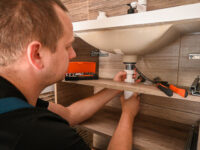How to Keep Your Wooden Fence in Good Shape
Every fence takes a beating daily from the elements and debris. But routine maintenance keeps damage to a minimum.
Simple fixes like tightening loose boards or removing mildew keep your fence looking great. Local experts stabilize leaning sections, repair splintered wood and rusty hardware, and install gates that are safe and secure. Contact Nashville Fence Repair for professional help.
Wood fences require constant maintenance to keep them healthy and strong. This is especially important during the winter when the elements are at their harshest. Checking the condition of your wooden fence and taking quick action to fix problems can avoid expensive repairs down the road.
Rain and Snow
Rain and sleet cause wood fences to constantly absorb moisture, which weakens the fibers in the boards and creates mold, mildew and rot. To prevent this, be sure to apply a waterproof stain or sealant. Also, regularly clean the fence to remove dirt and debris from between boards. Keeping leaves and other organic material from wedged in the gaps will also promote airflow and reduce moisture accumulation.
Shifting Posts
Over time, wooden fence posts can shift and weaken, causing the rest of the system to lean. This is usually caused by the concrete footings not being set deep enough or with proper ballast, but may also be a result of shifting soil.
To prevent this, inspect your fences after every major storm to make sure the posts are still in place and stable. A simple test can be to run a piece of string along the tops of the posts – if the line is level and straight, the post is in good shape.
Knotholes
The changing temperatures of the season can cause your wood fence to expand and contract, causing moisture to seep into the knot holes of the boards. This can lead to rot and pest infestations, so it is important to seal these holes as soon as they appear. To do this, get a couple small cans of water based wood putty – one lighter and one darker than the color of your boards, and another with a tint that is almost identical to the wood color of your fence.
Once you have these, fill in the knot holes with the putty and allow it to dry. When it is dry, rub the area with medium-grit sandpaper to smooth the surface and even out the appearance of the putty. It may take several attempts to completely repair the holes.
Posts and Rails
Posts are the backbone of any fence, ensuring stability and providing the foundation for all other components. They can be made from wood or other materials, such as vinyl. Posts are often pressure-treated to increase their lifespan and resist rot and insect damage. They are available in a wide range of heights and styles. Most posts are round, but some are square. Square posts are used for a more sturdy look, especially in areas where a fence will be exposed to wind.
Once the posts are set, rails, also known as stringers, can be affixed to them. Fence rails are essentially two-by-fours that run horizontally across the posts and provide support for the fence boards. Depending on the style and height of the fence, there can be one to four rails.
In general, the bottom rail should be installed with the narrow side up to help limit sagging of the fence. This helps to keep the board away from ground moisture, which can lead to rot or warping. The top rail can be installed with the wide side up or down, depending on your preference. The bottom and cap rails may be made from the same material as the fence boards or from a different material such as steel, to add strength and aesthetics.
Some fencing contractors cut the tops of the fence posts at a 30-degree angle to prevent rain, dew or other moisture from accumulating on the top of the post. This can also help to avoid water ingress at the top of the posts and reduce the need for future repairs.
Fence contractors should check the topography of the area before installing a fence to ensure that a post is not in a ledge. If a post is in a ledge, it will require special equipment to install and can double the cost of each post.
Some fencing contractors use a method of putting in concrete around the posts to protect them from being lifted by ice or snow. This involves removing the soil around the post, using a concrete mix to fill in the hole and then placing the post in it. This process is more expensive than using a traditional concrete mix, but it provides added stability and extends the life of the fence post.
Panels
A fence panel is the main body of a garden fence, and it’s available in a wide range of colors, styles, and materials. Whether you choose wood, vinyl, or ornamental aluminum, a well-maintained fence panel can add security and aesthetic value to your property.
The most common choice for fence panels is wood, and it’s a budget-friendly option that can offer years of use with very little maintenance. Wood fences need to be treated or stained every few years to prevent moisture damage, rotting, mildew growth, and insect infestation.
Another popular choice for fence panels is vinyl, which is durable and resistant to temperature changes, pests, fading from sun exposure, and weathering. Vinyl is also easy to clean with a quick soap and water rinse, and it’s a great option for families with kids and pets.
If your wood fence has gaps between the slats, you can easily fix this by nailing or screwing new slats into place. However, if the problem is more serious, it may be time to replace your entire fence panel.
It’s important to conduct accurate measurements before ordering your fencing materials. This ensures that you have enough materials to complete your project and reduces waste. When measuring your property, consider factors like tree lines, driveways, and slopes, as these can impact where your fence can be placed.
You’ll also need to take into account any gates that will be installed in your fence. These will interrupt the panel line, and you’ll need to subtract their width from your total linear footage calculation. It’s also worth considering the type of gate you want, as this will influence your panel count.
If you’re looking for a fence solution that can reduce noise pollution, look no further than our 6ft Decibel Noise Reduction Fence Panels. These are designed to mute traffic, neighbouring lawn equipment, and other ambient sounds by up to 30 decibels. They’re a perfect addition to any modern garden or urban living space. For more information or to begin a quote, please get in touch.
Gates
A fence with a broken or unlatched gate can be more of a security risk than it is helpful for keeping intruders out. This problem is usually easy to fix, and your handyman can install new latches, hinges and locks that are best suited to your gates size, weight and needs.
Gates are typically more decorative than fence panels and can add to a homes curb appeal in a variety of ways, from hardware and unique latches to different colors that match or stand out from the rest of your home or landscape. When a gate’s finish starts to chip, peel or fade it not only looks bad but leaves the wood exposed to the elements. A service technician can strip the old finishing, reapply it and apply sealant to lock out moisture and prolong the life of your gate.
As with all of the other parts of your fence, the gates will eventually need to be repaired or replaced. This is a good time to consider adding extra security features, such as a keypad or an electronic entry system that can only be activated by authorized personnel. This will help to deter unwanted visitors and keep intruders out of your property.
Wood fences take a beating every day, being hit by the wind and rain, as well as being regularly brushed up against by lawnmowers, hedge trimmers and other garden equipment. This can cause the boards to splinter, which not only spoils the appearance of your fence but is also a health hazard. If your wooden fences are splintering, it’s best to replace them with new ones.
The bottoms of iron fence panels should never be in direct contact with the ground, as this can cause them to rust. A service technician can wash and scrub the surface of a fence to remove any dirt or grime that has collected on it. This should be done before the primer is applied, to ensure that it adheres properly.
Once a fence is repaired and re-stained it will look better than ever and add to the value of your home or business. It will also provide your family, friends and guests with a safe, secure and private space to enjoy your outdoor space.






